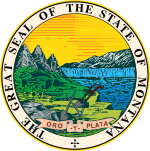
The 1976 United States Senate elections was an election for the United States Senate. Held on November 2, the 33 seats of Class 1 were contested in regular elections. They coincided with Democrat Jimmy Carter's presidential election and the United States Bicentennial celebration. Although almost half of the seats decided in this election changed parties, Carter's narrow victory did not provide coattails for the Democratic Party. Each party flipped seven Senate seats, although, one of the seats flipped by Democrats was previously held by a Conservative.

The 1964 United States Senate elections were held on November 3. The 33 seats of Class 1 were contested in regular elections. Special elections were also held to fill vacancies. They coincided with the election of President Lyndon B. Johnson by an overwhelming majority, to a full term. His Democratic Party picked up a net two seats from the Republicans. As of 2023, this was the last time either party has had a two-thirds majority in the Senate, which would have hypothetically allowed the Senate Democrats to override a veto, propose constitutional amendments, or convict and expel certain officials without any votes from Senate Republicans. In practice, however, internal divisions effectively prevented the Democrats from doing so. The Senate election cycle coincided with Democratic gains in the House in the same year.

The 1958 United States Senate elections were elections for the United States Senate which occurred in the middle of President Dwight D. Eisenhower's second term. Thirty-two seats of Class 1 were contested in regular elections, the new state of Alaska held its first Senate elections for its Class 2 and 3 seats, and two special elections were held to fill vacancies.

Roy Elmer Ayers was a U.S. Democratic politician. He served as a member of the United States House of Representatives and as the 11th Governor of Montana. He was the first governor of Montana to be born in what would become the state of Montana.

The 2014 United States Senate elections were held on November 4, 2014. A total of 36 seats in the 100-member U.S. Senate were contested. Thirty-three Class 2 seats were contested for regular six-year terms to be served from January 3, 2015, to January 3, 2021, and three Class 3 seats were contested in special elections due to Senate vacancies. The elections marked 100 years of direct elections of U.S. senators. Going into the elections, 21 of the contested seats were held by the Democratic Party, while 15 were held by the Republican Party.

The 1996 United States Senate election in Montana took place on November 5, 1996. Incumbent United States Senator Max Baucus, who was first elected in 1978 and was re-elected in 1984 and 1990, ran for re-election. He was unopposed in the Democratic primary, and moved on to the general election, where he faced a stiff challenge in Denny Rehberg, the Lieutenant Governor of Montana and the Republican nominee. Despite Bob Dole's victory over Bill Clinton and Ross Perot in the state that year in the presidential election, Baucus managed to narrowly win re-election over Rehberg to secure a fourth term in the Senate.
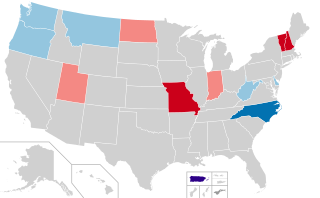
United States gubernatorial elections were held on November 8, 2016, in 12 states and two territories. The last regular gubernatorial elections for nine of the 12 states took place in 2012. The last gubernatorial elections for New Hampshire, Oregon, and Vermont took place in 2014, as Oregon held a special election due to the resignation of Governor John Kitzhaber, while the governors of New Hampshire and Vermont both serve two-year terms. The 2016 gubernatorial elections took place concurrently with several other federal, state, and local elections, including the presidential election, Senate, and House elections.

The 2014 congressional election in Montana was held on November 4, 2014, to elect the U.S. representative from Montana's at-large congressional district. Between 1993 and 2023, Montana had one at-large seat in the House.

The 1924 United States Senate election in Montana took place on November 4, 1924. Incumbent United States Senator Thomas J. Walsh, who was first elected to the Senate in 1912 by the state legislature, and re-elected in 1918 by popular vote, ran for re-election. He was unopposed in the Democratic primary.
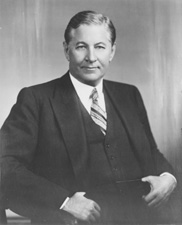
The 1934 United States Senate special election in Montana took place on November 6, 1934. Incumbent United States Senator John E. Erickson, who, as governor, had appointed himself to the seat in 1933 upon the death of Thomas J. Walsh, ran for re-election. However, he was defeated in the Democratic primary by James E. Murray, who was the former Silver Bow County Attorney and the Chairman of the State Advisory Board of the Public Works Administration. In the general election, Murray defeated Scott Leavitt, a former United States Congressman who had represented Montana's 2nd congressional district, and an independent candidate in a landslide to win his first term in the Senate.

The 1990 United States Senate election in Montana took place on November 6, 1990. Incumbent United States Senator Max Baucus, who was first elected in 1978 and was re-elected in 1984, ran for re-election. After winning the Democratic primary, he moved on to the general election, where he was opposed by Allen Kolstad, the Lieutenant Governor of Montana and the Republican nominee. Baucus ultimately ended up defeating Kolstad in a landslide, winning his third term with ease.

The 1946 United States Senate election in Montana took place on November 5, 1946. Incumbent United States Senator Burton K. Wheeler, who was first elected to the Senate in 1922, and was re-elected in 1928, 1934, and 1940, ran for re-election. He was challenged in the Democratic primary by Leif Erickson, the Chief Justice of the Montana Supreme Court, and, following a close election, was narrowly defeated by Erickson. In the general election, Erickson faced State Senator Zales Ecton, the Republican nominee. Ultimately, Ecton defeated Erickson by a fairly wide margin, winning his first and only term in the Senate. Another Republican would not be elected Senator from Montana until 42 years later, when Conrad Burns narrowly won the 1988 election.
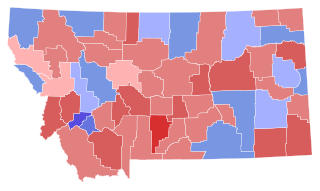
The 1988 Montana gubernatorial election took place on November 8, 1988. Incumbent Governor of Montana Ted Schwinden, who was first elected in 1980 and was re-elected in 1984, declined to seek re-election to a third term, creating an open seat. Stan Stephens, the former president of the Montana Senate, won a close Republican primary, and advanced to the general election, where he was opposed by Thomas Lee Judge, Schwinden's predecessor as governor and the Democratic nominee. Though the general election was hotly contested, Stephens ultimately defeated Judge, becoming the first Republican to win a gubernatorial election in Montana since 1964.

The 1960 Montana gubernatorial election took place on November 8, 1960. Incumbent Governor of Montana J. Hugo Aronson, who was first elected governor in 1952 and was re-elected in 1956, declined to run for re-election. Donald Grant Nutter, a former state senator, narrowly won the Republican primary, and advanced to the general election, where he was opposed by Paul Cannon, the Lieutenant Governor of Montana and the Democratic nominee. Nutter defeated Cannon by a fairly wide margin, winning his one and only term as governor, as he would die just a year into his term.
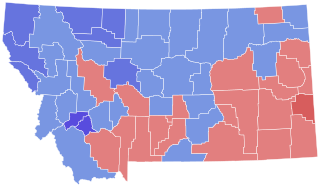
The 1948 Montana gubernatorial election took place on November 2, 1948. Incumbent Governor of Montana Sam C. Ford, who was first elected Governor in 1940 and was re-elected in 1944, ran for re-election. He won the Republican primary and advanced to the general election, where he faced John W. Bonner, the former Attorney General of Montana and the Democratic nominee. Ultimately, Bonner defeated Ford handily in his bid for re-election, winning his first and only term as governor.

The 1944 Montana gubernatorial election took place on November 7, 1944. Incumbent Governor of Montana Sam C. Ford, who was first elected Governor in 1940, ran for re-election. He won the Republican primary and moved on to the general election, where he was opposed by Leif Erickson, a former Chief Justice of the Montana Supreme Court and the Democratic nominee. Although then-President Franklin D. Roosevelt comfortably won the state in that year's presidential election, Ford defeated Erickson by a wide margin to win his second and final term as governor. This election is the first time that an incumbent Republican Governor of Montana was re-elected or won re-election.

The 1936 Montana gubernatorial election took place on November 3, 1936. Incumbent Governor of Montana Elmer Holt, who became governor in 1935 upon the death of Frank Henry Cooney, ran for re-election. He was challenged in the Democratic primary by a number of challengers, and was narrowly defeated for renomination by United States Congressman Roy E. Ayers of Montana's 2nd congressional district. Ayers advanced to the general election, where he faced Frank A. Hazelbaker, the former Lieutenant Governor of Montana and the Republican nominee. Following a close election, Ayers narrowly defeated Hazelbaker to win what would be his first and only term as governor.

The 1928 Montana gubernatorial election took place on November 6, 1928. Incumbent Governor of Montana John E. Erickson, who was first elected governor in 1924, ran for re-election. Erickson only narrowly won the Democratic primary against future Governor Roy E. Ayers, and advanced to the general election, where he was opposed by U.S. Attorney Wellington D. Rankin, the former Attorney General of Montana. Although Herbert Hoover carried the state in a landslide in the presidential election that year, Erickson won re-election to his second term as governor in a landslide over Rankin.

The 1924 Montana gubernatorial election took place on November 4, 1924. Incumbent Governor of Montana Joseph M. Dixon, who was first elected governor in 1920, ran for re-election. Dixon won a competitive Republican primary, and moved on to the general election, where he faced John E. Erickson, a former district court judge and the Democratic nominee; and Frank J. Edwards, the 1916 Republican nominee for governor and the Farmer–Labor Party nominee. Ultimately, Erickson managed to defeat Dixon in his bid for re-election, winning what would be the first of three terms as governor.
S. C. (Steve) Arnold was a longtime legislator in the state of Montana who served as Montana Secretary of State from 1955 to 1957. A Republican, Arnold supported Dwight D. Eisenhower and won the 1956 Montana GOP presidential primary in Eisenhower’s stead, as a “favorite son” candidate.

